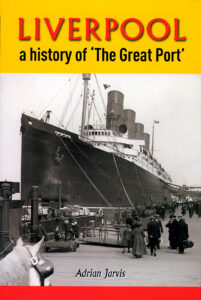 Liverpool History Press – 2014 – 280 pages – 170 colour and black and white photographs, maps and Illustrations. Paperback.
Liverpool History Press – 2014 – 280 pages – 170 colour and black and white photographs, maps and Illustrations. Paperback.
ISBN 978-0-9573833-1-9. £14.99 (£9.99 to LNRS members. Contact Ron Jones: ron@rja-mpl.com or Tel: 0151 637 1122).
In producing this re-appraisal of the history of the port of Liverpool, Adrian Jarvis has put his extensive academic research and deep local knowledge to extremely good use. This book covers the 300 years between 1672 (when land was first acquired to begin the long process of conversion to dock use) and 1972 (when the old Mersey Docks and Harbour Board was wound up). It is a fascinating tale of impressive growth to majestic supremacy, sad decline almost to extinction and steady recovery from the 1980’s to the present.
The author has performed a valuable service in avoiding well-worn local themes and bravely concentrating on more prosaic areas of port history well-hidden but utterly deserving of independent analysis. It is not a history of Liverpool. The slave trade is mercifully avoided, as is the detail of labour disputes and local politics. Social history is addressed only as it touches on dockside communities, their commercial and industrial activities. Adrian has mined the extensive but arcane archives of the old Mersey Docks and Harbour Board and revealed a series of remarkable ‘killer facts’.
One is the constant difficulty the MDHB had in achieving strategic planning in the face of rapid technological change, amidst the pressures from shipowners, Liverpool Council and various government agencies. The launching of bigger and bigger ships, with their increased cargoes and passenger traffic forced ports into a constantly reactive process to modernise existing docks and build new ones, along with their attendant handling and transportation facilities. The Board constantly found itself between the ‘rock’ of shipping line demands and the ‘hard place’ of raising capital for new dock development (on the financial markets), whilst maintaining revenue to sustain port operations. Another ‘killer fact’ is that the Dock Engineer spent nearly all of the port’s capital funds and 75% of its annual revenue in these rounds of remorseless modernisation. Yet another finding is that whilst the Board was secretive in much of its commercial activities, it operated almost free of corruption.
Particularly revealing is the way the big shipping lines (at the expense of other port users) would minimise the ‘official’ net registered tonnage capacities of their ships to avoid port charges. Jarvis reveals for example, that when the superliners Mauretania (1) and Lusitania went into the service, total port dues paid by Cunard to the MDHB went down, not up!
Adrian Jarvis has succeeded superbly in producing a history of the Port of Liverpool that combines painstaking research, operational insight and good humour with an independent perspective. The book is attractively presented and features stunning photographs and illustrations. It is strongly recommended to anyone interested in the underlying truth of the Port of Liverpool’s story.
Tony Melling
Available from various Merseyside outlets including Waterstones, Merseyside Maritime Museum, Museum of Liverpool, Tate Liverpool, Anglican and Roman Catholic Cathedrals, Blackwell’s Bookshop (Brownlow Hill), News from Nowhere (Bold Street), Liverpool Tourist Information Centre (Albert Dock), Williamson Art Gallery bookshop, Linghams, Heswall, Gould’s, Heswall, Port Sunlight Garden Centre and Gordale Garden Centre, Burton, Wirral. Or order on-line direct from the publishers, Liverpool History Press (www.liverpoolhistorypress.co.uk)